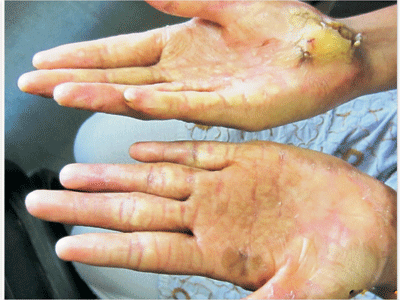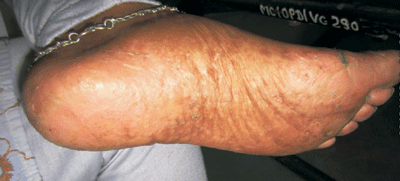A 12-year-old female presented to the Dermatology Outpatient
Department with thickening of palms and soles. To start
with, the palmoplantar skin was red at the age of 4 months.
Subsequently, a thick yellowish hyperkeratosis appeared and
expanded to attain the present status. On examination,
yellowish hyperkeratotic plaques were found on the palms and
soles, with sparing of the arches of feet and sharp cut-off
at the wrist. (Fig. 1 and 2) The dorsa
of the fingers showed mild involvement, with a
scleroderma-like thickening of the skin distal to the
proximal interphalangeal joints. The oral mucosa, teeth and
nails were normal. Systemic examination was
non-contributory. Patient’s father had similar lesions on
palms and soles. A provisional diagnosis of Diffuse
Palmoplantar Keratoderma (PPK) was made. Histopathological
examination of the skin biopsy taken from the patient’s sole
revealed orthokeratotic hyperkeratosis, hypergranulosis and
acanthosis without epidermolysis. Hyphae were not detected
on examination of the squames in the scraping; with 10%
potassium hydroxide. Based on clinical and histopathological
findings, diagnosis of "Unna-Thost variety of Diffuse Non-epidermolytic
Palmoplantar Keratoderma" (NEPPK) was done. Both, the
patient and her father have been prescribed topical
tretinoin and emollients, and at present, they are under
follow-up.
 |
|
Fig. 1 Yellowish
hyperkeratotic plaques on palms.
|
 |
|
Fig. 2 Hyperkeratosis
sparing the arches of feet.
|
Unna-Thost disease (Diffuse NEPPK) is
inherited in an autosomal dominant manner, underlying gene
defect being in 12q11-q13 or Desmoglein 1. The disease
develops in early childhood and persists throughout life.
Clinically, there is hyperkeratosis on the palms and soles.
Clinical differential diagnoses include Howel–Evans syndrome
(focal keratoderma on pressure sites, leukokeratosis of the
oral mucosa and esophageal cancer); Clouston syndrome (hidrotic
ectodermal dysplasia, hypotrichosis and nail dystrophy),
Huriez syndrome (scleroatrophic changes on the dorsal aspect
of the hands and hypoplastic nails in addition to the PPK).
Secondary dermatophyte infection, leading to maceration and
peeling of the palms and soles, is a common complication.
These conditions persist for life and may be passed on to
the next generation. Treatment options include salicylic
acid 4-6% in petrolatum, 50% propylene glycol in water under
plastic occlusion, lactic acid- and urea-containing creams
and lotions.

